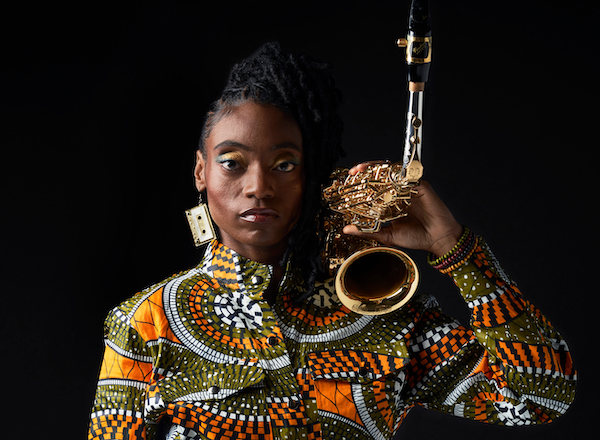Dec 9, 2025 12:28 PM
In Memoriam: Gordon Goodwin, 1954–2025
Gordon Goodwin, an award-winning saxophonist, pianist, bandleader, composer and arranger, died Dec. 8 in Los Angeles.…

Lakecia Benjamin’s latest album features compositions by Alice Coltrane and John Coltrane.
(Photo: Elizabeth Leitzell)When saxophonist Lakecia Benjamin finished the fourth song of her set, “Pursuance,” at Le Poisson Rouge in Manhattan on Jan. 11, a techie gave her a time warning. The amped-up crowd expressed dismay. “Don’t tempt me,” she quipped into the mic. “Any woman who made a Coltrane album will play all night.” The notion seemed credible. That evening, the seemingly indefatigable Benjamin played with ferocious joy, keeping time in her silver high-tops, chatting up the audience, even throwing her shiny jacket on the stage in mock surrender during a particularly blistering tenor saxophone solo by guest artist Marcus Strickland. In all aspects of her craft, the young alto player seemed to be testing established boundaries as much as she was lionizing the artistry of her musical forebears.
The performance, part of Winter JazzFest, was something of a preview for Benjamin’s latest undertaking, the self-produced Pursuance: The Coltranes (Ropeadope), out March 27. Several of the prominent players from the album joined Benjamin on the LPR stage: In addition to Strickland, they included bassist Reggie Workman, saxophonist Greg Osby and violinist Regina Carter. These talents represent only a smattering of the musicians who contributed to the recording. But with more than 40 artists on the new release, Benjamin would have been hard pressed to fit its entire personnel on stage, even if all the musicians had been available.
“One problem I’ve always had in life is dreaming really big,” Benjamin said during an interview at a Lincoln Center café the day before the LPR show. Off stage, with her gleaming horn tucked away in its case, Benjamin revealed a different side of her musical persona: the conscientious student of jazz history, smitten with the innovators who first charted the artistic path that she now treads, albeit in silver high-tops.
Benjamin doesn’t exaggerate when she talks about dreaming big. To date she’s released two albums under her own name, both with casts of more than 20 musicians: Retox (Motéma) in 2012 and Rise Up (Ropeadope) in 2018. With those—devoted as much to funk and soul as jazz—Benjamin began to develop a feel for bandleading, a skill that separates forward-looking jazz innovators from the merely talented.
“In every [past] generation, you had to be a bandleader, somebody who decided to take the steps to change things,” she said. “If you’re playing with people, it feels great, but bandleaders have a way harder job.”
Benjamin likely came to this realization during her years of experience as a side player to a host of in-demand pop, soul, funk and jazz acts—Gregory Porter, David Murray, Stevie Wonder, Alicia Keys, The Roots, Macy Gray, Missy Elliot, Talib Kweli and Anita Baker among them. These gigs started pouring in soon after Benjamin graduated from the jazz program at The New School in her hometown of New York.
Pursuance is Benjamin’s most ambitious project so far, not only for its eye-popping lineup, but for the magnitude of its subject matter: the compositions of Alice Coltrane (1937–2007) and John Coltrane (1926–’67). The meaningful twist here is the equal weight that Benjamin gives to Alice’s work, intentionally dividing the album’s 13 tracks about equally between the two musicians.
For Benjamin, this balanced approach is only natural: Growing up, she was transfixed by Alice’s otherworldly compositions before she even knew that John existed.
“A friend of mine had turned me on to Alice. She was friends with [Alice’s] family,” Benjamin recalled. “We would play her music all the time, and it really inspired me to start writing and creating. Then, out of the blue, I opened the booklet [to one of Alice’s CDs] and I saw the name John Coltrane. I asked, ‘Who’s John Coltrane? Does Alice have a brother?’”

Goodwin was one of the most acclaimed, successful and influential jazz musicians of his generation.
Dec 9, 2025 12:28 PM
Gordon Goodwin, an award-winning saxophonist, pianist, bandleader, composer and arranger, died Dec. 8 in Los Angeles.…

Belá Fleck during an interview with Fredrika Whitfield on CNN.
Jan 13, 2026 2:09 PM
The fallout from the renaming of the John F. Kennedy Center for the Performing Arts to include President Donald…

Flea has returned to his first instrument — the trumpet — and assembled a dream band of jazz musicians to record a new album.
Dec 2, 2025 2:01 AM
After a nearly five-decade career as one of his generation’s defining rock bassists, Flea has returned to his first…

The success of Oregon’s first album, 1971’s Music Of Another Present Era, allowed Towner to establish a solo career.
Jan 19, 2026 5:02 PM
Ralph Towner, a guitarist and composer who blended multiple genres, including jazz — and throughout them all remained…

Dec 11, 2025 11:00 AM
DownBeat presents a complete list of the 4-, 4½- and 5-star albums from 2025 in one convenient package. It’s a great…